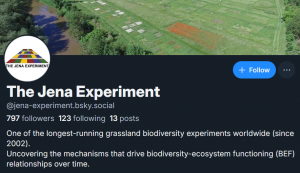New publication from Schmid et al. in Grassland Research: Removing subordinate species in a biodiversity experiment to mimic observational field studies
Positive effects of plant species richness on community biomass in biodiversity experiments are often stronger than those from observational field studies. This may be because experiments are initiated with randomly assembled species compositions whereas field communities have experienced filtering.
Methods
We compared aboveground biomass production of randomly assembled communities of 2–16 species (controls) with experimentally filtered communities from which subordinate species were removed, resulting in removal communities of 1–8 species.
Results
Removal communities had (1) 12.6% higher biomass than control communities from which they were derived, that is, with double species richness and (2) 32.0% higher biomass than control communities of equal richness. These differences were maintained along the richness gradient. The increased productivity of removal communities was paralleled by increased species evenness and complementarity.
Conclusions
Result (1) indicates that subordinate species can reduce community biomass production, suggesting a possible explanation for why the most diverse field communities sometimes do not have the highest productivity. Result (2) suggests that if a community of S species has been derived by filtering from a pool of 2S randomly chosen species it is more productive than a community derived from a pool of S randomly chosen species without filtering.
Reference
Schmid, B., Schmitz, M., Rzanny, M., Scherer-Lorenzen, M., Mwangi, P. N., Weisser, W. W., Hector, A., Schmid, R., & Flynn, D. F. B. (2022). Removing subordinate species in a biodiversity experiment to mimic observational field studies. Grassland Research, 1( 1), 53– 62. https://doi.org/10.1002/glr2.12009



